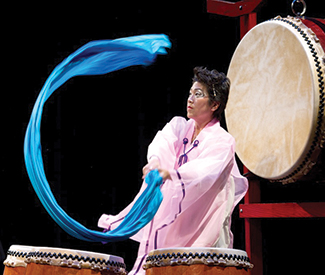arts@sfbg.com
DANCE It took Los Angeles-born Melody Takata, founder and artistic director of Japantown’s GenRyu Arts, four years to convince her parents to let her study dance. It was her older sister’s “fault” — she had studied ballet for a while but didn’t like it and stopped. “So my parents didn’t want to go through that experience again,” Takata remembered. But Takata was living in a Japanese American community that embraced traditional arts, and ballet wasn’t what she had in mind.
When she finally got her way, she went all out, starting at eight with Odori (Japanese dance), including Bon Odori, a popular circular community dance integral to the Odon festival that honors the ancestors. At 10, she began studying Nihon Buyo (Japanese classical dance) and did so for a decade. During that time, she acquired a repertoire of some two dozen solos drawn from Kabuki. “Some of them, I perform excerpts only; they are too long for an audience to sit through,” she observed. They are also expensive to perform because they have to be licensed, and the elaborate costumes (up to $10,000 a piece) are costly, even on loan. Yet recently, Takata reprised her studies with her 93-year-old Nihon Buyo teacher, wanting to deepen her insight into this noble art.
So what attracted her to this rigorous and highly stylized form that includes — besides dancing from within heavy costumes — an intricate gestural vocabulary of fans, swords, scarves, umbrellas, and even canes? “I just liked becoming all these different characters,” she smiled.
Adding to her dance studies, at 13 she started on the shamisen (“three-stringed”) instrument; at 15 she joined the Taiko group Los Angeles Matsuri. “Dance is my first love, and music is part of that,” she explained. Taiko sharpens rhythmic acuity, but for Takata, it’s also part of a communal experience.
She creates multifaceted works in which she wants “to explore our story” through Taiko, spoken word, contemporary movement, music, traditional Japanese dance, and video. Regular collaborators include Francis Wong and Asian Improv aRts, as well as actor-comedian Todd Nakagawa and Chicago filmmaker, bassist, shamisen expert, and Taiko drummer Tatsuo Aoki.
Though steeped in tradition, Takata doesn’t want these practices to become enshrined as museum pieces. In 2012, as part of Chicago’s annual Taiko Legacy festival, Takata — dressed in a black evening gown and elbow-length white gloves — performed her solo Yodan, which melded dance and Taiko. Her works may examine issues particular to her community, but they also resonate with broader audiences. In 2010, Tsuki no Usagi (Rabbit in the Moon) was created to mark the centennial of the Angel Island Immigration Center, where 60,000 Japanese passed through 1910-1940. The work is rooted in a popular myth in which a rabbit was willing to sacrifice its life for others. As a reward it was lifted to the moon where, Takata said, “it can be seen on either side of the ocean.”
The themes of 2011’s Fox and Jewel — which added jazz, animation, and poetry into the dance-and-Taiko mix — no doubt resonated with Bay Area audiences. Fox is a magical shape-shifting being who comes to the aid of humble folks; in this piece, it’s a mochi-shop owner who takes on real estate speculators who continue to threaten the existence of the local Japantown.
Takata’s newest work, Shadow to Shadow, premieres Sat/12 as part of this year’s Japan Week. The hourlong piece draws inspiration from Junichiro Tanizaki’s poetic In Praise of Shadows, in which he wistfully looks at Japan’s increasing Westernization and the essential differences between two cultures that are still learning to coexist.
BE THERE
Physically, Enrico Labayen may be small, but in importance, he stands tall. Faced with multiple physical challenges and exorbitant medical bills, the choreographer and artistic director of Labayen Dance/SF is in the fight of his life. So the dance community is stepping up with “Encore for Enrico,” a benefit performance to help one of its own. Though he was an early member of Lines Ballet and a longtime ballet teacher, Labayen may best be known as a prolific and wide-ranging choreographer for his own company. But he also is a generous supporter for those who come here from other places, as he did. Recent arrivals like Victor Talledos and Daiane Lopes da Silva found an early home in his company. Health permitting, Labayen will perform a new solo, Will You Still Be There? *
SHADOW TO SHADOW
Sat/12, 2 and 7:30pm, free (donations accepted; sign up for free tickets at brownpapertickets.com/event/704453)
Tateuchi Hall
1830 Sutter, SF
“ENCORE FOR ENRICO”
Sat/12, 7:30pm, $25-$30
Dance Mission Theater
3316 24th St, SF

